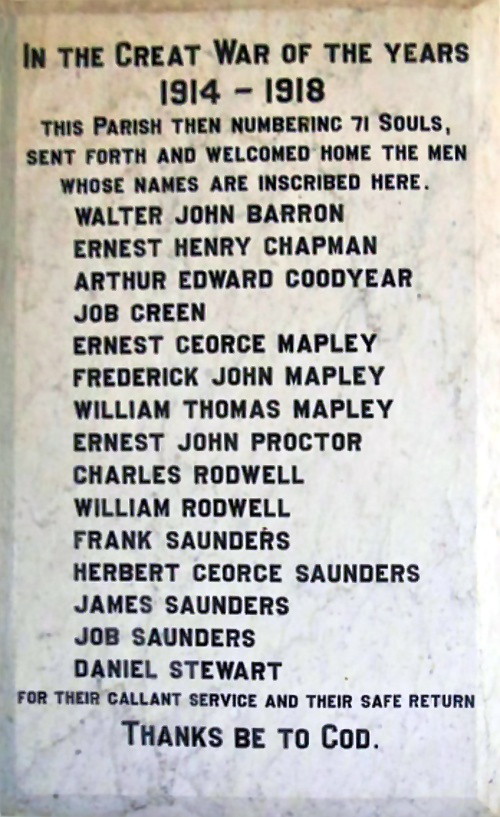|
Lest We
Forget
by
Wendy Austin
In
Britain the searing grief experienced by millions following the
horrors of World War One left many people numb and in a state of
shock. Gradually, all seemed to agree that the sacrifice
of the serving men should be commemorated in some way, but the
length of time it took to decide on the style, siting, and fund
raising method for a war memorial varied greatly from community
to community. (The war memorial in Tring was most unusual
in that it was erected and dedicated shortly before the
Armistice of November 1918 – in fact Tring was written up as
setting a splendid example to the nation as a whole.)
In
the villages north of Tring, it took three years from the time
that the subject was first broached until the erection of the
completed memorial. The historic day for Long Marston and
Marsworth fell on Sunday afternoon 7th August 1921 when the
second Lord Rothschild performed both unveiling ceremonies,
dressed in the uniform of his regiment, the Bucks Yeomanry.
Long
Marston selected as its design a Celtic cross carved from a
single slab of silver-grey granite set upon three high steps,
and sited in the centre of the village near the school (which
no-one then dreamed would be totally destroyed by bombing twenty
later during the next world conflict). It was estimated
that the cost would be £400 after allowing for carving the names
and inscription, supplying a rail fence, laying turf, and
planting ornamental trees. It is recorded that the
foundations were set by James Chandler & Son of Long Marston,
and the erection carried out by Newman & Harper of Aylesbury.
Before the ceremony the villagers assembled to the music of the
Long Marston Band, and ex-servicemen under the charge of
Sergeant Proctor formed a guard of honour for Lord Rothschild.
As it happened, a London troop of Boy Scouts were camped in
nearby fields, and two of their officers acted as standard
bearers. The short service was conducted by the Rev. R. H.
Rowden, assisted by Mr. Bates of Aylesbury representing the
village’s Wesleyan Methodist Church, following which a speech
given by Lord Rothschild in which he laid great stress on “the
call of duty”. Whether or not the fine words held any
shreds of comfort for the bereaved wives, mothers, fathers,
fiancées, and others, we cannot know.
The
party then progressed to Marsworth to perform a similar
ceremony. Marsworth architect A. J. Gurney charged no fee
for his design of a Gothic cross, which was sited in a prominent
position in the churchyard on rising ground fronting the road.
Constructed of Portland stone gifted by William Mead, owner of
Tring Flour Mill, the cost of carving and erection amounted to
£140, which was raised by public subscription. Of the 55
men of Marsworth who served in the Great War, 11 did not return
and their names are inscribed on the base of the cross. A
similar speech by Lord Rothschild was followed by the sounding
of the Last Post by trumpeters from the Wendover Boys’ Brigade,
and their band led the singing of the National Anthem.
Three
months later on 3rd October 1921, the village folk of Wilstone
experienced the same sad occasion as their neighbours.
Again, the design chosen was a Celtic cross made of Cornish
granite, but it did have one notable difference, for the base
was of stone that originally formed part of the swing bridge
over the Wendover Arm of the Grand Junction Canal. This,
and the generous donation of railings by local farmer Percy
Mead, helped to keep costs down to £140. After a service
on the village green led by the Rev. R. H. Rowden, Percy Mead
read out the nine names of the fallen and Capt. G. M. Brown MC
of Tring unveiled the memorial and addressed the crowd.
Following a minute’s silence, a prayer was said by Arthur
Bagnall representing Wilstone Baptist Church and the Long
Marston Band, under the baton of Mr Prothero, played the Last
Post followed by the Reveille sounded by a troop of RAF
trumpeters.
The
scenes enacted in these villages no doubt followed a similar
pattern and were accompanied by the same emotions as those
experienced by every community across the land. But it is
good to remember that in Puttenham things turned out
differently. This tiny hamlet can be called a ‘Thankful
Village’, that is, one that lost no men in the carnage of the
Great War. The term was first used by historian Arthur Mee,
who estimated that at most there were 32 such villages and
hamlets in the whole of Britain, although he could only
positively identify 24. Puttenham was certainly the only
one in Hertfordshire, and the relief and joy that greeted the 15
returning servicemen can only be imagined, although how much
physical and mental scarring they carried home with them is
impossible to say. At the Harvest Thanksgiving service of
1925, a tablet was unveiled in the south aisle of St. Mary’s
Church. Its simple inscription speaks for itself:

|
|